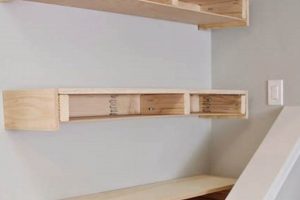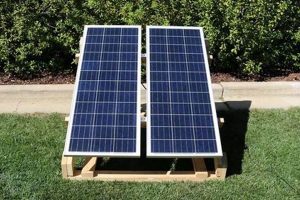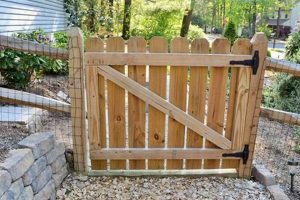The construction of a personalized Polynesian-themed home bar allows individuals to create a unique and festive entertainment space. This undertaking typically involves utilizing readily available materials and basic construction techniques to replicate the aesthetic of traditional South Pacific island establishments. A common example involves repurposing pallets and bamboo to create a bar structure, adorned with tropical decorations and thematic lighting.
The advantages of such a project include cost savings compared to purchasing prefabricated units, customization options to suit specific spatial and aesthetic preferences, and the inherent satisfaction derived from a hands-on creative endeavor. Historically, the popularity of Polynesian-themed establishments in Western culture emerged in the mid-20th century, influencing home decor trends and prompting individuals to replicate the atmosphere within their own residences.
Subsequent discussion will address material selection for weather resistance, optimal design considerations for functionality and visual appeal, and various decorative elements that enhance the immersive experience of such a recreational installation.
Construction Advisories
The following guidelines provide recommendations for successful construction, emphasizing durability and aesthetic coherence.
Tip 1: Material Selection for Weather Resistance: Prioritize treated lumber or naturally weather-resistant species like cedar or redwood. This minimizes degradation from exposure to the elements, extending the structure’s lifespan.
Tip 2: Foundation Stability: Ensure a solid and level foundation, whether concrete pavers, a deck platform, or a properly prepared ground surface. An unstable base compromises structural integrity and safety.
Tip 3: Incorporate Adequate Bar Top Surface Area: Plan for sufficient countertop space to accommodate beverage preparation, serving, and guest interaction. Insufficient space diminishes functionality and enjoyment.
Tip 4: Implement Effective Drainage: Design the bar top with a slight slope and install appropriate drainage channels to prevent water accumulation and potential damage. Proper drainage mitigates moisture-related issues.
Tip 5: Strategically Position Lighting: Utilize low-voltage landscape lighting, tiki torches, or string lights to create ambiance and enhance visibility. Careful placement avoids glare and optimizes the desired atmosphere.
Tip 6: Consider Local Building Codes: Research and comply with all applicable building codes and regulations regarding construction, electrical work, and plumbing, if applicable. Compliance ensures safety and avoids potential legal complications.
Tip 7: Focus on Thematic Cohesion: Select decorations and accessories that complement the Polynesian theme, such as bamboo accents, thatched roofing, and tropical plants. Cohesive design enhances the overall aesthetic appeal.
Observance of these recommendations contributes to a more durable, functional, and visually appealing final product.
The ensuing section will outline advanced design considerations for enhancing the user experience and maximizing the utility of the constructed bar.
1. Material Durability
Material durability represents a critical determinant in the longevity and overall value of any constructed Polynesian-themed home bar. Selecting materials resistant to environmental factors is essential for preserving structural integrity and aesthetic appeal over time.
- Weather Resistance
Exposure to rain, sunlight, and temperature fluctuations necessitates the use of materials capable of withstanding these conditions. Untreated wood, for example, is prone to rot and decay, requiring frequent maintenance or replacement. Selecting treated lumber, cedar, or synthetic alternatives mitigates these risks, extending the bar’s service life.
- Insect and Pest Resistance
Materials vulnerable to insect infestation can compromise structural soundness. Bamboo, a common aesthetic element, can attract pests if not properly treated. Employing pest-resistant materials or applying protective coatings minimizes the risk of damage and maintains the bar’s integrity.
- Moisture Management
The accumulation of moisture can lead to mold growth and material degradation. Adequate drainage systems, coupled with the use of water-resistant sealants and finishes, are essential for preventing water damage and maintaining a hygienic environment. Improper moisture management can lead to costly repairs and health hazards.
- Structural Load Capacity
The materials used in the bar’s frame and countertop must possess sufficient strength to support anticipated loads, including the weight of beverages, equipment, and patrons. Failure to account for load capacity can result in structural failure and potential injury. Reinforcing structural elements with durable materials ensures stability and safety.
The careful selection and implementation of durable materials directly correlates with the long-term cost-effectiveness and enjoyment derived from a Polynesian-themed home bar. Neglecting material durability can lead to premature deterioration, requiring costly repairs and diminishing the bar’s overall value as an entertainment asset.
2. Structural Integrity
The creation of a Polynesian-themed home bar necessitates a rigorous focus on structural integrity to ensure safety, longevity, and functionality. Inadequate structural planning directly results in instability, potential collapse, and compromised user safety. For instance, a bar constructed with insufficient support beams may buckle under the weight of a fully stocked countertop, posing a significant hazard. The importance of structural soundness cannot be overstated; it is a foundational component upon which the entire structure’s viability depends.
Practical application of structural engineering principles is crucial. Load-bearing capacity of materials must be calculated accurately, considering factors such as the weight of the bar top, stored beverages, and potential leaning pressure from users. Real-world examples include utilizing reinforced joints, employing sturdy framing techniques, and ensuring proper weight distribution throughout the structure. Furthermore, consideration must be given to environmental factors such as wind load and seismic activity, depending on geographic location. Ignoring these considerations during construction can lead to premature failure and costly repairs.
In summary, structural integrity is paramount to the successful construction and safe operation of a Polynesian-themed home bar. Addressing potential weaknesses during the planning and building phases mitigates risks, ensures user safety, and enhances the long-term value of the finished pro
ject. Challenges may arise in accurately calculating load-bearing requirements or adapting designs to irregular spaces, but these can be overcome through careful planning and consultation with experienced builders or structural engineers. This understanding connects directly to the broader theme of responsible and effective home improvement practices.
3. Thematic Authenticity
Thematic authenticity represents a critical component in the successful realization of a Polynesian-themed home bar. It dictates the degree to which the constructed environment accurately reflects the cultural and aesthetic characteristics associated with traditional South Pacific island establishments. Deviation from established stylistic norms diminishes the immersive quality of the bar and weakens its intended purpose as a simulated tropical retreat.
- Material Selection and Representation
The selection of materials directly influences the perceived authenticity. Bamboo, thatch, and carved wood elements are commonly associated with Polynesian design. Substituting these materials with modern or readily available alternatives, such as plastic or metal, can detract from the overall thematic integrity. The judicious use of appropriate materials strengthens the illusion of a genuine tropical environment.
- Decorative Artifacts and Cultural Accuracy
The inclusion of decorative artifacts, such as tiki masks, Polynesian artwork, and nautical elements, contributes to the thematic narrative. However, the accuracy and provenance of these artifacts are important considerations. The use of generic or inaccurate representations can undermine the authenticity of the bar’s design. Sourcing items that are culturally representative enhances the immersive experience.
- Color Palette and Atmospheric Lighting
The selection of colors and lighting plays a crucial role in creating an authentic Polynesian atmosphere. Earthy tones, tropical hues, and warm, subdued lighting are characteristic of the style. The use of overly bright or contrasting colors can disrupt the intended ambiance. Strategic lighting, such as tiki torches or string lights, contributes to the desired tropical aesthetic and enhances the sense of escapism.
- Acoustic Environment and Auditory Cues
The integration of appropriate auditory elements can further enhance thematic authenticity. The inclusion of Polynesian music, the sound of simulated rain or ocean waves, or the use of bamboo wind chimes contributes to the immersive experience. Conversely, the presence of discordant sounds or modern music can detract from the intended ambiance. Attention to the acoustic environment amplifies the perceived authenticity of the bar.
The synergistic combination of these elements, when carefully considered and implemented, directly influences the overall success of a Polynesian-themed home bar. Prioritizing thematic authenticity elevates the immersive experience, transforming the space into a convincing and enjoyable tropical retreat, as opposed to a mere imitation. The investment in accurate and appropriate materials and decor is essential for achieving the desired level of realism and creating a truly memorable entertainment environment.
4. Spatial Optimization
Spatial optimization, in the context of a constructed Polynesian-themed home bar, denotes the strategic allocation and arrangement of elements within a defined area to maximize functionality, efficiency, and aesthetic appeal. This process necessitates a comprehensive evaluation of available space, user needs, and design considerations to achieve an optimal configuration.
- Ergonomic Bar Layout
An ergonomic bar layout prioritizes efficient workflow for beverage preparation and service. Countertop height, sink placement, and equipment accessibility should be optimized to minimize unnecessary movement and strain. For example, a well-designed layout places frequently used items within easy reach of the bartender, reducing preparation time and enhancing overall efficiency. A poorly designed space could lead to constricted movement and difficulty in interacting with guests.
- Guest Circulation and Seating
Adequate space for guest circulation and comfortable seating arrangements are crucial for enhancing the user experience. Strategic placement of seating areas and pathways ensures smooth traffic flow and prevents overcrowding. A cramped or poorly designed space can impede movement and create a sense of discomfort. Considerations include aisle widths, seating heights, and the provision of adequate legroom to accommodate diverse user needs.
- Storage Solutions and Inventory Management
Efficient storage solutions are essential for managing beverage inventory, glassware, and bar accessories. Maximizing vertical space with shelving and utilizing under-counter storage can optimize space utilization. Organized storage systems facilitate efficient retrieval of items and prevent clutter, contributing to a more visually appealing and functional bar area. Without this, the accumulation of supplies can lead to an unprofessional and chaotic setting.
- Aesthetic Integration and Thematic Cohesion
Spatial optimization should consider the integration of thematic elements and aesthetic design principles. The arrangement of decorations, lighting fixtures, and architectural features should complement the overall Polynesian theme and enhance the visual appeal of the space. Cluttered or poorly arranged decorations can detract from the intended aesthetic and create a sense of visual disharmony. An organized space enhances the immersive tropical feel.
These facets of spatial optimization underscore the importance of careful planning and execution in the construction of a functional and visually appealing Polynesian-themed home bar. Attention to ergonomic principles, guest circulation, storage solutions, and aesthetic integration maximizes the utilization of available space and contributes to a more enjoyable and immersive entertainment environment. In contrast, a poorly optimized space diminishes functionality and detracts from the overall experience.
5. Budget Management
Effective budget management is crucial for the successful execution of a DIY Polynesian-themed home bar project. Careful allocation of financial resources ensures the completion of the project within predefined limits, while maintaining desired quality and aesthetic standards. Without proper budgetary oversight, cost overruns and compromised design integrity are likely outcomes.
- Material Cost Estimation and Control
Accurate estimation of material costs is paramount. Price variations in lumber, bamboo, thatching, and decorative elements necessitate diligent research and comparison shopping. For example, sourcing reclaimed lumber or opting for alternative materials, such as synthetic thatch, can significantly reduce expenditures. Failure to adequately research costs may result in exceeding the allocated budget for core structural components.
- Tool and Equipment
Acquisition StrategiesThe acquisition of necessary tools and equipment, ranging from basic hand tools to power saws and drills, represents a significant budgetary consideration. Renting specialized tools, borrowing from acquaintances, or purchasing used equipment can minimize upfront costs. A strategy that favors cost-effective acquisition methods prevents unnecessary strain on the overall financial plan.
- Contingency Planning for Unexpected Expenses
Budgetary planning should incorporate a contingency fund to address unforeseen expenses, such as material defects, design modifications, or unexpected construction complications. Allocating a percentage of the total budget, typically 10-15%, to a contingency fund provides a financial buffer against potential setbacks, ensuring project completion despite unforeseen challenges.
- Labor Cost Management (If Applicable)
While DIY projects often imply self-execution, instances may arise where professional assistance is required for specialized tasks, such as electrical wiring or plumbing. Clearly defining the scope of work and obtaining competitive bids from qualified contractors enables effective management of labor costs. Neglecting to budget for potential labor expenses can lead to significant financial strain.
Successful budget management within a DIY Polynesian-themed home bar project involves a proactive approach to cost estimation, strategic resource acquisition, and contingency planning. Adherence to a well-defined budget safeguards against financial instability and ensures the realization of the project within established parameters, thereby enhancing the overall value and enjoyment derived from the finished construction.
6. Tool Proficiency
The successful construction of a Polynesian-themed home bar necessitates a demonstrable level of tool proficiency. Competency in operating a range of hand and power tools is directly correlated with the quality, safety, and efficiency of the building process. Lack of adequate skill in tool utilization can lead to structural deficiencies, aesthetic imperfections, and potential safety hazards.
- Woodworking Tool Competence
Proficiency in using woodworking tools, such as saws (circular, miter, and hand saws), drills, and sanders, is essential for accurately cutting, shaping, and finishing lumber components. For example, precise miter cuts are required for constructing structurally sound and visually appealing bar frames. Inaccurate cuts can compromise the integrity of the structure and necessitate costly material replacements. Inefficient use of sanding equipment can result in uneven surfaces and detract from the final aesthetic.
- Fastening and Joining Techniques
Skill in employing appropriate fastening and joining techniques, including screwing, nailing, and using adhesives, is crucial for assembling structural elements and securing decorative components. The improper use of fasteners can result in weakened joints and potential structural failure. Selecting the correct type of screw or nail for a given application, and understanding the proper application of wood glue, ensures long-term stability and aesthetic appeal.
- Measuring and Leveling Accuracy
Accuracy in measuring and leveling is paramount for ensuring structural integrity and aesthetic symmetry. The use of measuring tapes, levels, and squares is essential for precise cuts and alignment. Inaccurate measurements can result in uneven surfaces, misaligned components, and a compromised structural foundation. For example, an unleveled bar top can create an unstable surface for beverages and equipment, posing a safety hazard.
- Safety Protocol Adherence
A comprehensive understanding and adherence to safety protocols when operating power tools and handling materials is non-negotiable. The proper use of safety glasses, ear protection, and respiratory masks is essential for preventing injuries and minimizing exposure to hazardous materials. Negligence in safety protocol adherence can lead to severe injuries and project delays. Safe tool operation and responsible material handling are integral aspects of tool proficiency.
These facets of tool proficiency collectively contribute to the successful creation of a safe, structurally sound, and aesthetically pleasing Polynesian-themed home bar. Deficiencies in any of these areas can compromise the final product and potentially pose significant risks. A comprehensive understanding of tool operation and safety, combined with practical application and meticulous attention to detail, is essential for achieving the desired outcome.
7. Safety Protocols
The construction of a Polynesian-themed home bar, while a recreational endeavor, necessitates stringent adherence to safety protocols due to the inherent risks associated with construction activities and the use of power tools. Failure to implement and enforce appropriate safety measures can result in injuries ranging from minor cuts and abrasions to severe lacerations, fractures, or even electrocution. The construction of such a bar frequently involves cutting, shaping, and assembling wood, often requiring the operation of saws, drills, and other potentially hazardous equipment. The absence of protective eyewear, for example, can lead to eye injuries from flying debris, while the lack of appropriate respiratory protection can result in the inhalation of harmful dust particles or fumes. Furthermore, improper handling of electrical wiring during the installation of lighting or appliances can cause electric shock or fire. The correlation between strict safety practices and a successful, injury-free project outcome is direct and demonstrable.
Practical application of safety protocols includes, but is not limited to, the mandatory use of personal protective equipment (PPE) such as safety glasses, ear protection, gloves, and respirators. Implementation requires a thorough understanding of the operating instructions for all tools and equipment, and adherence to manufacturer-recommended safety procedures. For example, before operating a power saw, the operator should ensure that all safety guards are in place and functioning correctly, and that the workpiece is securely clamped to prevent movement. Furthermore, electrical work should only be performed by individuals with the necessary qualifications and expertise, and all wiring must comply with local electrical codes. Prior to commencing any task, a thorough risk assessment should be conducted to identify potential hazards and implement appropriate control measures. Real-world examples of accidents occurring during similar construction projects underscore the critical importance of these precautions.
In summary, safety protocols are not merely optional guidelines but essential components of a Polynesian-themed home bar construction project. Neglecting these protocols increases the risk of injury, project delays, and potential legal liabilities. By prioritizing safety through comprehensive planning, rigorous training, and consistent enforcement of safety measures, individuals can mitigate these risks and ensure a successful and enjoyable construction experience. The challenges associated with implementing and maintaining strict safety practices can be overcome through education, awareness, and a commitment to prioritizing well-being above expediency.
Frequently Asked Questions
The following addresses common inquiries and concerns regarding the construction of a personalized Polynesian-themed bar structure. These answers provide guidance based on typical construction scenarios and established safety protocols.
Question 1: What is the typical cost associated with constructing a tiki bar?
The total expenditure varies substantially based on material selection, dimensions, and complexity of design. A basic structure utilizing reclaimed materials may cost several hundred dollars, while elaborate designs employing premium materials and professional assistance can escalate into thousands.
Question 2: What are the essential tools required for this type of construction?
A fundamental toolkit includes a circular saw, drill, measuring tape, level, hammer, and safety glasses. Depending on the design complexity, additional tools such as a miter saw, jigsaw, and sander may be necessary.
Question 3: What type of wood is most suitable for outdoor tiki bar construction?
Weather-resistant wood species such as cedar, redwood, or treated lumber are recommended. These materials exhibit inherent resistance to moisture, decay, and insect infestation, extending the lifespan of the structure.
Question 4: Are building permits typically required for this type of project?
Local building codes and regulations vary. Contacting the local building department is essential to determine permit requirements based on structure size, location, and complexity. Failure to obtain necessary permits may result in fines or required demolition.
Question 5: How can the structure be protected from the elements?
Applying a weather-resistant sealant or stain is crucial for protecting the wood from moisture damage and UV exposure. Regular maintenance, including cleaning and reapplication of sealant, is recommended to prolong the structure’s lifespan.
Question 6: What are the primary safety considerations during construction?
Wearing appropriate personal protective equipment, including safety glasses, ear protection, and gloves, is mandatory. Familiarization with tool operating instructions and adherence to safe work practices are essential for preventing injuries.
These answers provide a foundational understanding of key aspects related to constructing a personalized Polynesian-themed bar. Proper planning, material selection, and adherence to safety guidelines are paramount for a successful outcome.
The following section will delve into design considerations and stylistic enhancements that can further elevate the aesthetic appeal of such a structure.
Conclusion
The preceding exploration of “diy tiki bar” construction has encompassed a broad spectrum of critical elements, from material selection and structural integrity to thematic authenticity, spatial optimization, budget management, tool proficiency, and safety protocols. The successful realization of a personalized Polynesian-themed bar hinges upon a comprehensive understanding and diligent application of these principles.
Therefore, prospective builders are encouraged to prioritize thorough planning, meticulous execution, and unwavering adherence to safety guidelines. The construction of a “diy tiki bar” represents a significant undertaking; a commitment to quality and responsible building practices will ensure a durable, aesthetically pleasing, and safe recreational space for years to come.







